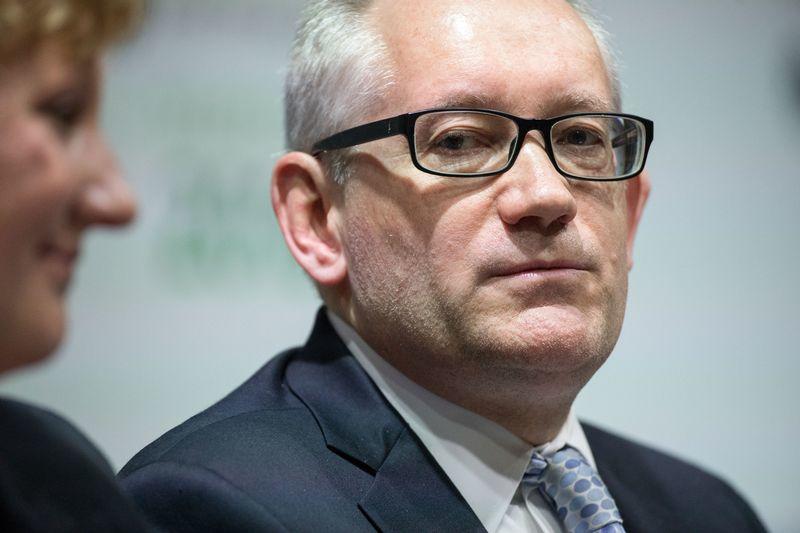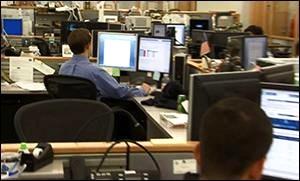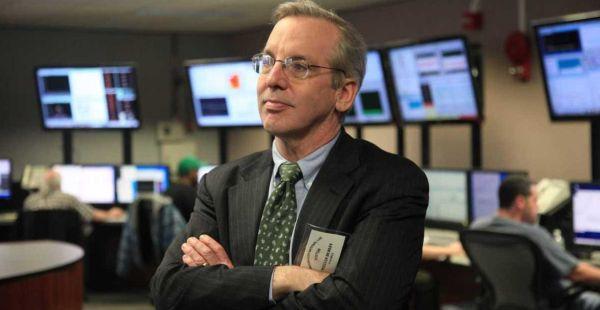It was almost ten years ago that we first profiled the most important trading desk in the world: not one situated in any of the (increasingly empty) massive trading floors of the world's commercial banks located in either the financial district, midtown or Connecticut, but the one inside the 9th floor of 33 Liberty Street, the home New York Fed, the one which is also known in trader folklore as the "Plunge Protection Team."
This is what we said back then:
Mr. Sack, 39 years old, is an economist who runs the markets group at the Federal Reserve Bank of New York. The group runs the Fed's trading, making it the bridge between the marble corridors of the Federal Reserve in Washington and the bustling trading floors of Wall Street.The center of life in the markets group is a glass-enclosed conference room situated next to a small cluster of trading desks on the ninth floor of the New York Fed. It overflows with people for a daily 9:20 a.m. meeting run by Mr. Sack. A few stray pictures of Alan Greenspan, the former Fed chairman, still hang on pillars nearby.The markets group grew enormously during the crisis, from about 225 employees to 400 people who monitor the markets for the Fed, manage its portfolio and run the many new trading programs it has started. The Fed holds more than 20,000 individual securities.
Of course, back then said "most important trading desk" was controlled by one Brian Sack, then only 39-year-old, who has since moved on to the far more lucrative pastures of DE Shaw. Sack was replaced in the summer of 2012, by the levitating market wizard, Simon Potter, who promptly realized that to crush the bears one simply had to crush the VIX specs, and the rest would promptly follow.
Then, in the end of May 2019, something unexpected happened: Simon Potter, arguably the most important trader in the world, manning the world's most important trading desk, unexpectedly announced his "resignation." Not only that, but Potter took with him the second most important person at the NY Fed's "Plunge Protection Team", the head of the Financial Services Group, Richard Dzina.

What was odd, as we briefly noted two months ago, was the sudden and unexpected nature of this departure: it came from nowhere, and prompted some very delicate and substantial questions about continuity at the desk that has so far managed to keep the US stock market from entering a bear market since the global financial crisis over a decade ago.
Now, thanks to Bloomberg, we have a much more detailed look into what transpired at the trading desk of the "Plunge Protection Team", and what we learn is that the past year said institution which forms the bedrock of support for the US capital market has been gripped by what at times is sheer chaos.
Why? Perhaps it will not come as a surprise to anyone, that the reason for said chaos is another career economist, in this case the "new" president of the New York Fed, John Williams (no relation to the Star Wars guy).
As Bloomberg details in a "must read" report, "an unusual level of internal tension broke out in recent weeks at the fortress-like Federal Reserve Bank of New York in lower Manhattan." This was prompted by the sudden departure of the two longtime officials mentioned above, which "shook staff, sank morale and drew attention to the leadership of the New York Fed under John Williams as he enters his second year at the helm." And yes, this is the same John Williams who two weeks ago prompted a mini market tantrum following one of the most epic communication fuck ups by a central banker.
As Bloomberg writes "the story involves Simon Potter, who ran the all-important markets desk, and Richard Dzina, head of the financial services group. Both were abruptly relieved of their roles in late May by Williams. Little explanation was given, but according to current and former New York Fed employees, as well as those close to the bank, the nature of the exits, by fault or design, seemed to be a warning: fall in line."
It is not clear exactly what the two titans of US capital markets had to "fall in line" for, but two things are certain - i) Potter did not "resign", he was fired by Williams, and ii) now that an economist with zero capital markets experience is in charge, and following his termination of Potter and Dzina, the world is one step closer to collapse as a clueless PhD hack is in charge of the most important market in the world.
The economist in question is John Williams, whom Bloomberg laughably described as "a widely respected and oft-cited monetary economist who ran the San Francisco Fed for seven years" which is amusing for a regional Fed that was at the epicenter of the housing crisis (granted under Yellen, not Williams, but still), and which is best known for incinerating taxpayer funds for such profoundly insightful research reports as "why is water wet" (we jest, but a real example of their cutting edge research was whether it was still worth going to college). In any case, when Williams was appointed for the top job in New York - a Fed which has a far closer link to capital markets than any other - this "raised eyebrows from the outset. A finance-industry background has traditionally been seen as a key qualification, something he lacked."
Bingo. And what's worse, Williams - in what was likely an ego tantrum - inexplicably fired the two most important people in his inner circle who have had their pulse on the capital markets for the past decade.
The consequences were immediate, and visible to all:
Williams, who during his San Francisco Fed days often mentioned his reluctance to pay too much attention to short-term swings in the markets, came under fire on July 18 after saying in a speech that central banks should act quickly “at the first sign of economic distress.”With the remarks coming just a day before Fed officials entered a quiet period prior to their July 30-31 policy meeting, traders immediately took his comments to mean a more-aggressive rate cut was in store. The New York Fed issued a rare clarification walking back his comments later that day, causing another sharp move in the opposite direction.
As Bloomberg adds, the "kerfuffle prompted Ward McCarthy, chief financial economist at Jefferies, to say in a July 22 note to clients that “until proven otherwise, President Williams will remain a communication liability and a probable source of market volatility." This, again, is the guy who is in charge of the world's most important trading desk!
The Williams fiasco It also caught the attention of President Donald Trump, who has been openly critical of Fed policy. He tweeted, “I like New York Fed President John Williams first statement much better than his second.”
Williams inability to communicate with markets aside, Bloomberg correctly points out that "as Williams reorganizes the leadership ranks and puts his stamp on the New York Fed, the ousters of Potter and Dzina leave the reserve bank without two of its most experienced hands."
For those readers who are unfamiliar with our historical obsession with Potter, Bloomberg gives a broad overview of his background:
Potter, who holds a Ph.D. in economics from University of Wisconsin-Madison, started at the New York Fed in 1998. As head of the markets desk, he oversaw the end of the Fed’s massive bond-buying program known as quantitative easing, as well as the unwind that began in October 2017.Potter was also responsible for briefing policy makers on the state of financial markets at the Fed’s rate-setting meetings. He met with Powell about three weeks after he was relieved of his duties, according to the chairman’s calendar. A Fed spokesman declined to comment on the reason for the meeting or what was discussed.Dzina, a former Army officer, began his career at the Fed as a bank examiner in 1991 before working his way up the ranks. In addition to leading the financial services group, he also managed a key network central to the U.S. payments system called Fedwire. He’s been described in conversations with those who know him as a steady hand who projected confidence and a team-first attitude. His oft-repeated credo was, “Mission First, People Always.”
So what caused the rift that led to the termination of Potter and his associate? Curiously, that's one thing that remains unknown. As Bloomberg writes, "it’s still unclear whether any specific disagreements prompted the removals. But those close to the New York Fed say Potter and Dzina, who were known for being strong-minded, did not align with Williams on issues related to managerial strategy."
In any event, there’s little doubt many were surprised by how it all went down, Bloomberg notes. What is curious is that until now at least, the market was not aware that the two stalwart guardians of the S&P500, and the heads of the PPT departed after what appears to have been a clash of egos - and styles - with the current, and supremely clueless, head of the NY Fed. The market may be in for a very rude awakening.
Ironically, Potter's termination is something right out of Trump's pinkslipping of Comey:
Williams told Potter of the decision over the phone while the latter was out of town and was scheduled to travel to Hong Kong for a speech on regulatory reform, according to people with direct knowledge of the situation, who aren’t authorized to speak publicly.
And just like at the FBI, the NY Fed appears to be turning on Williams:
Employees put questions to Williams at a town hall-style meeting in June, two weeks after the departures, expressing their frustration over the message Williams seemed to be sending, according to people familiar with the matter. Williams responded by talking about the need for a cohesive vision among the bank’s top executives, without elaborating on the specifics of the decision.
Typical econobabble - lots of SAT words, little substance, and absolutely no clue what to do when the market crashes, which at this rate may come very soon.
* * *
Fast forward to today when the NY Fed has yet to announce who will succeed Potter and Dzina on a permanent basis. In the meantime, Michael Strine, the institution’s first vice president and Williams’ second-in-command, is managing Fedwire. Traditionally, the network is overseen by the first vice president, but was instead delegated to Dzina by Williams’ predecessor, William Dudley, when Strine was promoted to the role in 2015, according to Bloomberg.
To be sure, whoever replaces Potter and Dzina will have plenty to contend with.
On Wednesday, the Fed reduced its benchmark interest rate for the first time in over a decade and signaled more cuts may be in store later this year. New York Fed staffers have also been charged with looking into a new repurchase-agreement facility to provide liquidity to the banking system as cash becomes increasingly scarce. No less important are efforts to modernize Fedwire, which suffered a rare outage this year.
And then there is the risk of a sharp market drop lingering behind every corner, as the only thing that keeps the market propped up is the traders' explicit faith (and hope) in the Fed's ability to support it. The problem is that with Williams at the helm of the PPT, such an ability does not exist. And the moment the market realizes this is precisely when Potter will be so very desperately needed. Alas, at that very moment, Potter will be half a world away, sitting on a beach somewhere, collecting twenty zero percent...


